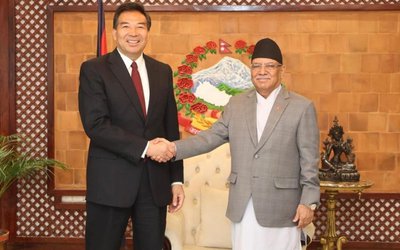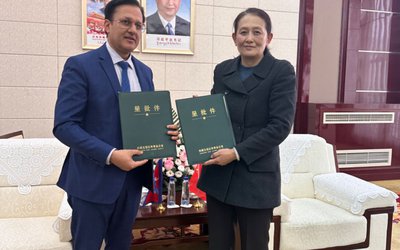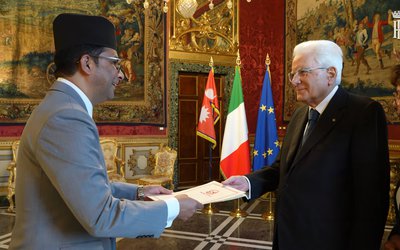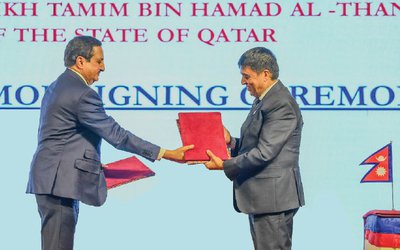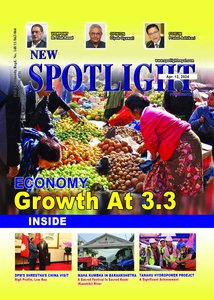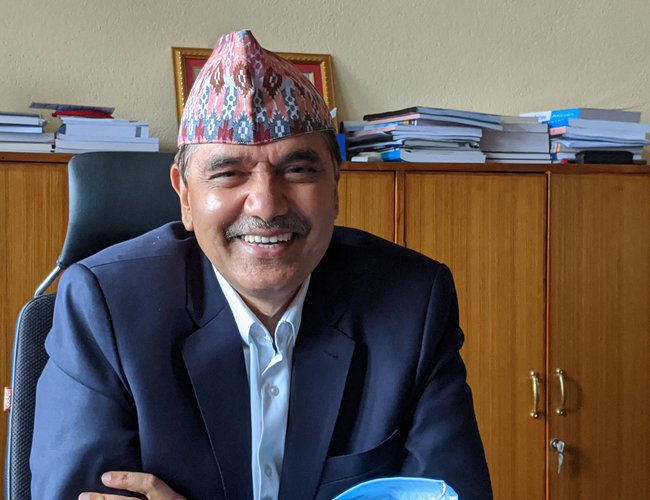
Although TBM was one of the proven alternative technologies to bore tunnels, it was regarded as a highly risky decision to introduce it in the first basin diversion irrigation project in Nepal. Taking all risks and criticisms, Secretary Belbase, as the regional director of Irrigation Directorate of Mid-West, had chosen to use TBM for the construction of the tunnel in the Bheri-Babai Diversion Multipurpose Project.
Bringing new technology always brought criticism and opponents. Belbase also faced harsh criticism for bringing TBM to Nepal. Not only within his own department, but higher officials at the ministry also tried to stop his move to bring TBM.
“I had few options: take the risk, face criticism for construction or drop such a highly important irrigation project to irrigate a large portion of land in mid-west and be on the safe side,” said Belbase. “I decided to take a risk for the sake of the project as well as to bring new technology in the country for future development. “ I am proud to say that my decision to bring TBM proved a success.”
On a very crucial choice between TBM and traditional Drilling, Blasting and Mucking (DBM), Belbase chose the former one. As the regional director Belbase had two options: wait for a series of technical studies reports of DBM, or search for an alternative technology appropriate to bore tunnel in the fragile geology of Chure mountain range.
“The construction of a 12.2-kilometer long tunnel from both ends with no feasible ADIT would likely take 7-8 years. In this context, it forced us to search for alternatives. In the process, I invited an engineer from the Chinese company CGGC to the site and discussed it further. After his visit, he proposed TBM would be most appropriate for the tunnel. After this suggestion, our team started studying TBM. At that time, we did not have any information about TBM,” writes Belbase on his Facebook wall.
Frustrated and discouraged by various people regarding the use of TBM, Belbase’s confidence and stand got the support after visiting TBM sites in India and acquiring information on various technical issues related to it. With this visit, Balbase along with his colleagues at the Ministry of Irrigation recommends TBM technology.
“Given India’s first failed experiences and hostile opinions of Nepali experts, doubtful opinion of few foreigners and severe negative perception prevailed at the top level. Yet we decided to go ahead. After this, our concern was the type of contractor to use for TBM. With so much of uncertain opinion, we had never thought that the TBM could drill tunnel so easily, particularly in the most vulnerable Tolikhola Fault and complete the work before the time,” said Belbase.
Boring tunnel in fragile geology like the Chure mountain range involves heavy risk. However, using TBM in that fragility is more challenging and risky. Choosing some risk, Belbase proposed to use TBM, a new technology for Nepal.
His decision proved technically right as the construction of the tunnel has completed before the schedule without any technical difficulties. Knowing the TBM’s success, Belbase as an executive director of the Water and Energy Commission, proposed TBM for 13 Kilometer long Sunkosi-Marine diversion projects. The project has already issued the tender for TBM. A Chinese company started the work in November 2017 and completed the tunnel in April 2019, earlier than the project timeline or just over 18 months.
In my 30 years of professional career, the preparation time for the TBM project was the best and most memorable time. “I would like to express regard to the colleagues of my team. Preparation of TBM design cost estimate and tender document by the manpower of Department of Irrigation without consultant was a big achievement.”
In the case of Bheri-Babai Diversion, TBM also showed that it is financially cheaper and technologically appropriate compared to DBM. In many cases, DBM proves costly and time-consuming. Melamchi Drinking Water Project is a good example of how DBM is costly.
Spending a lot of time and energy to convince higher officials, Belbase’s decision to use TBM proved the most realistic as Bherai-Babai Tunnel completed before the schedule.
Till a decade ago, it was unthinkable to use TBM in Nepal’s construction sector. However, the completion of the Bheri-Babai tunnel using TBM has changed the perception.
Given the tedious and time-consuming experience of the construction of the first phase of the Melamchi tunnel through DBM, the Ministry of Drinking Water is now considering whether it can use TBM in the construction of the second phase of Melamchi.
Belbase’s Suffering
As it says, every change comes with a price. One has to pay price for change and transformation. Taking a risk for technology even putting his position at stake, Belbase, a person with professional integrity, had to pay a heavy price in bringing modern technology in Nepal.
Soon after putting the tender process of TBM, Belbase was transferred as a Director-General of the Department of Irrigation to the Water and Energy Secretariat, which is known as a dumping ground. His promotion to secretary got delayed for almost four years.
Although WECS is regarded as a think tank created to feed policy level ideas on water, irrigation and energy-related issues to decision-makers, it is nowadays a shunting ground. However, Belbase, an active person, used his position in WECS to prepare the national water and energy strategy.
His support to TBM continued even from WECS. He provided much needed technical and other advice and encouraged concerned officials to solve the technical problems using TBM.
Until the breakthrough of the tunnel, Belbase used all his capacity to support the project and project staff.
TBM Option for Melamchi
Following the successful use of TBM in Bheri-Babai, the technology is now at the forefront in other tunnel boring projects. Frustrated by delay and cost escalation in the first phase of the Melamchi Drinking Water Project, there is now a debate on using TBM in its second phase.
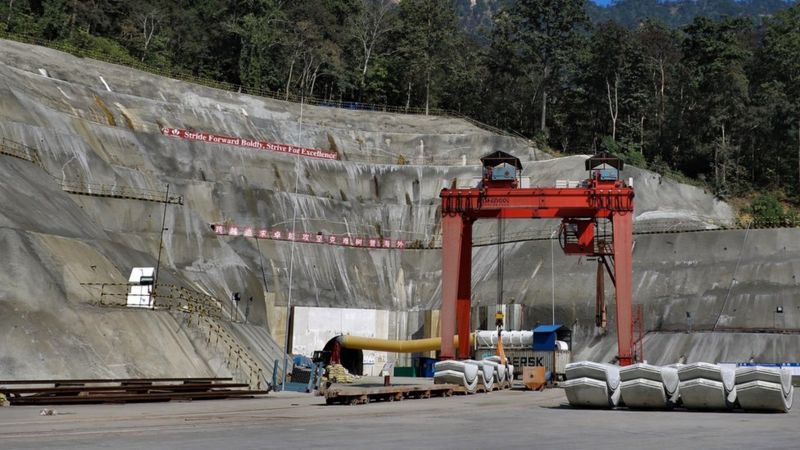
Preparation has begun to devise a new technology to excavate tunnel to bring water from Yangri and Larke rivulets to Kathmandu under the second phase of the much-awaited Melamchi Drinking Water Project.
The first diversion tunnel was excavated by DBM technology to divert raw water from the Melamchi rivulet to the Sundarijal outlet in the first phase. As this method was more time-consuming with a change in contractors and escalation of cost, the Ministry of Drinking Water and Melamchi Drinking Water Development Committee have mooted TBM.
With the use of TBM, the cost estimation was also made to expedite the excavation work through the DBM method to divert water from Yangri and Larke to the valley.
There was a preliminary estimate that it would cost Rs 10 billion for the excavation of around 11-km tunnel through this method. Since excavation seems to get delayed while working through the DBM method, the Melamchi Drinking Water Project has made a revision to give way to apply new technology.
Yangri is nine kilometers away from Ambathan of Helambu rural municipality – the origin of the Melamchi rivulet, while Larke is two kilometers away from Yangri. Both Yangri and Larke rivulets are located in Panhpokhari Thangpal rural municipality of Sindhupalchowk.
Melamchi Project’s Deputy Executive Director Kamal Raj Shrestha told RSS that preparation was in the final stage to work in the tunnel through the Tunnel Boring Machine (TBM) method.
“Machines will be used while excavating tunnel using this method. The TBM technology was also applied in the construction of the Bheri-Babai project. The project had successfully piloted the technology in Nepal,” said Shrestha.
What Is TBM
A tunnel boring machine, TBM, is a machine that is used to excavate tunnels. TBMs can bore through a variety of ground conditions, from hard rock to sand.
It will be most appropriate if there is no ADDITIONAL INSPECTION TUNNEL (ADDIT). In the tunnel-like Melamchi, where there is the need to bore from one end to another, TBM can be a game-changer.
To construct the tunnels, the TBMs will progressively line each tunnel with curved concrete segments as they dig. The twin tunnels will comprise 56,000 individual concrete segments.
TBM has different sizes and kinds. It can be used at the Metro Tunnel Project which will use mixed shield TBMs – commonly known as slurry TBMs – that are purpose-built to suit the local ground conditions. Once the TBM's cutter head bores through the ground, the excavated material will be mixed with slurry and transported back to the above-ground slurry treatment plant.

Each TBM is 7.28 meters in diameter, weighs more than 1,100 tones and is 120 meters long - as long as 3 E-Class trams end-to-end. The heaviest component is the cutter head, which weighs 100 tones and acts as a drill that can tunnel through rock six times harder than concrete. The face of the cutter head is 7.28m in diameter.
On average the TBMs will move around 10 meters every 24 hours. A crew of up to 10 people, including a TBM operator, will work on the TBM at any one time.
As Nepal is proposing a number of hydropower projects, multi-purpose projects, roads and subways, TBM technology, which was introduced by secretary Belbase, can be a game-changer to achieve progress in Nepal. Although he faced criticism, isolation and hostility within the Department of Irrigation and Ministry of Irrigation, secretary Belbase has shown the need to take risks for success.
As Melamchi is going to start its second phase soon following the completion of the first phase, the boring tunnel remains a major challenge. As it took 15 years to complete 27 kilometers of the tunnel in the first phase, increasing the cost and time, it may take 5 to six years for an 11-kilometer second phase tunnel through traditional DBM technology.

At a time when secretary Belbase, who is also known as the father of TBM in Nepal, is at the Ministry of Water Supply, no one needs to go for justification on using TBM as it can save time and cost of boring 11 KM Tunnel of Melamchi second phase.
Tale Of TBM in Bheri-Babai Diversion Project
By Madhav Belbase
Identified by Tahal Consulting Engineers Ltd, an Israeli firm in the 1970s, the Bheri-Babari Diversion project was placed as a high priority project in JICA’s Master Plan. JICA started Detail Project Report study in the 1990s and conducted highly important studies including alternative alignment for tunnel and current tunnel alignment. JICA withdrew the study without completing it during the Maoist conflict showing security concerns.
Following the withdrawal of JICA, the project was in limbo for years. It was revived in 2005 by the Nepal government. With the recommendation of then-secretary Shanker Prasad Koirala, Water Resources Minister Bishnu Poudel took a decision to carry out the construction of the project through the Department of Irrigation. After this decision, preparing DPR work was given to local consultancy firm BPC-JV. Under the DPR design, the tunnel was constructed through D &B.
However, construction of a 12.2-kilometer long tunnel from both ends with no feasible ADIT would likely take 7-8 years. In this context, it forced us to search for alternatives.
In the process, I invited an engineer from the Chinese company CGGC to the site and discussed it further. After his visit, he proposed TBM would be the most appropriate for the tunnel. After this suggestion, our team started studying TBM. At that time, we did not have any information as such about TBM.
Then, we were informed that TBM was used in Haidarabad to bore a 40-kilometer-long tunnel. Our team visited the construction site in Haidarabad and took the firsthand knowledge on how TBM worked. During our visit, we discussed whether TBM could be used in Nepal’s Shivalik range or not. We were briefed about the tragic story of the failure of TBM in Parbati 2 in India’s Himachal State with similar mountains like Nepal. Even with that bitter experience of Himanchal, we decided to move ahead with TBM in Nepal as the only alternative to divert the Bheri River to Babai.
With support from a few colleagues, including foreigners, among whom was one 80-year-old American TBM expert, the team conducted a preliminary study. The words of the old American still hunt my mind as he said with confidence, “I do not see anything here frightening for the TBM.” This inspired and encouraged us to take the decision.
On the basis of the preliminary study, colleagues, including Shiv Kumar Basnet, Ajaya Adhikary, Prakash Pudasaini and Manoj Panth, prepared a design and cost estimate. When we started talking about TBM, the majority of experts in Nepal blamed us as heading for an unviable technology. Had we surrendered before criticisms, Nepal would never have introduced TBM.
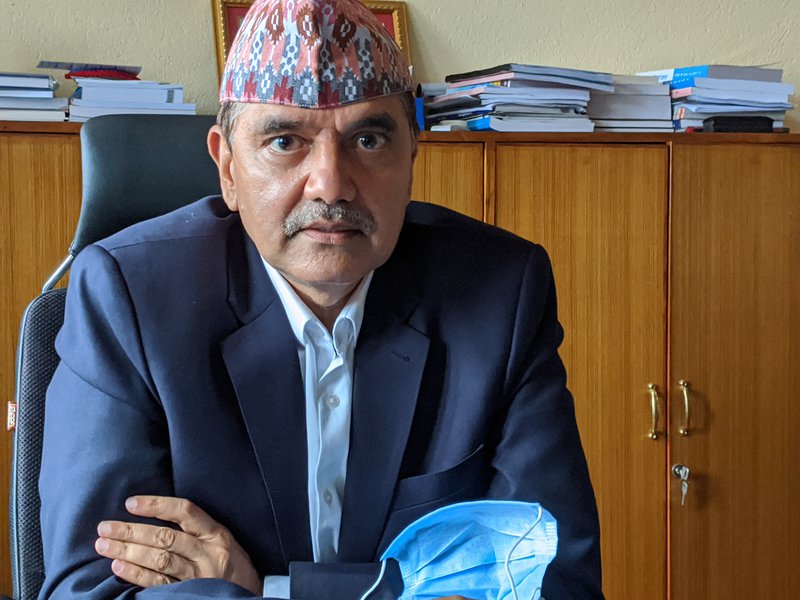
Even in the face of India’s first failed experience and hostile opinions of Nepali experts and doubts shown by a few foreigners, our concern was to bring an experienced TBM contractor. With so much uncertainty of opinions, we had never thought that the TBM could make the tunnel so easily, particularly in the most vulnerable Tolikhola Fault and complete the work. We had decided to publish the tender for tunnel only amid much confusion around.
Our original plan was to call a tender for headworks and powerhouse and sign the contract after crossing Tolikhola. However, it was not materialized in such a hostile situation around us. Forget about the opinion outside the Department of Irrigation, there were hostile opinions against TBM in the Ministry of Irrigation as well. Even some of my senior colleagues reportedly complained to the minister and secretary saying that Belbase was dragging the country into uncertainty using TBM.
Ignoring such accusations and firmly standing on the decision, we introduced TBM. However, the department took ownership of the project only after TBM speeded up work unexpectedly. At one time, there was no one in the department to give a proper direction and decision. Frustrated and demoralized by such behavior of seniors, Shivadai used to come to WECS to get some guidance.
Had TBM Tunnel, Head Works and PH contract been made simultaneously, what would have been the consequences in case of completion of HW and PH and incomplete tunnel? Due to the uncertain condition of TBM, we were unable to take that decision on that. Following the progress made by TBM, more than expected, some of our colleagues found time to question the total project contract issue.
In my 30 years of professional career, the preparation time for the TBM project was the best and most memorable time. I would like to express regards to the colleagues of my team. Preparation of TBM design cost estimate and tender document by the manpower of the Department of Irrigation without consultant was a big achievement. The completion of the work before the project time and at a lower than the contract price was another milestone.
(Translated from the author’s Facebook post)

Keshab Poudel
Poudel is the editor of New Spotlight Magazine.
- IWMI: SoLAR Global Science-Policy Forum Conference
- Apr 25, 2024
- CLA: Samriddhi For Skill Development
- Apr 23, 2024
- ECONOMY: Growth At 3.3
- Apr 16, 2024
- DPM’s SHRESTHA’S CHINA VISIT High Profile, Low Key
- Apr 14, 2024
- Maha Kumbha In Barahkshetra: A Sacred Festival In Sacred Koshi (Kaushiki) River
- Apr 09, 2024


